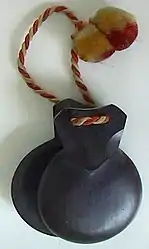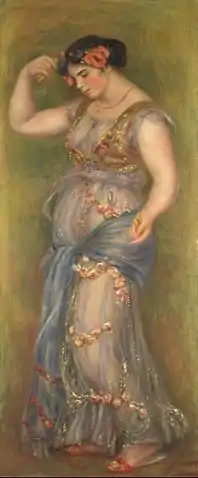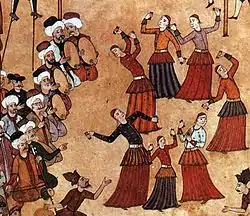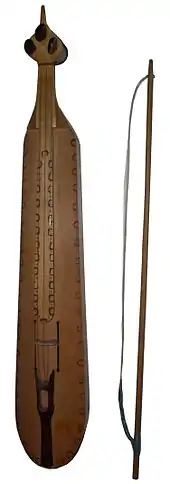Castanets
Castanets, also known as clackers or palillos, are a percussion instrument (idiophone), used in Spanish, Kalo, Moorish,[1] Ottoman, Italian, Sephardic, Swiss, and Portuguese music. In ancient Greece and ancient Rome there was a similar instrument called crotalum. The instrument consists of a pair of concave shells joined on one edge by a string. They are held in the hand and used to produce clicks for rhythmic accents or a ripping or rattling sound consisting of a rapid series of clicks. They are traditionally made of hardwood (chestnut; Spanish: castaño),[1] although fibreglass is becoming increasingly popular.
 Castanets | |
| Percussion instrument | |
|---|---|
| Classification | hand percussion |
| Hornbostel–Sachs classification | 111.141 (Directly struck concussive idiophone) |

In practice, a player usually uses two pairs of castanets. One pair is held in each hand, with the string hooked over the thumb and the castanets resting on the palm with the fingers bent over to support the other side. Each pair will make a sound of a slightly different pitch.
The origins of the instrument are not known. The practice of clicking hand-held sticks together to accompany dancing is ancient, and was practiced by both the Greeks and the Egyptians. In more modern times, the bones and spoons used in Minstrel show and jug band music can also be considered forms of the castanet.
During the baroque period, castanets were featured prominently in dances. Composers like Jean-Baptiste Lully scored them for the music of dances which included Spaniards (Ballet des Nations), Egyptians (Persée, Phaëton), Ethiopians (Persée, Phaëton), and Korybantes (Atys). In addition, they are often scored for dances involving less pleasant characters such as demons (Alceste) and nightmares (Atys). Their association with African dances is even stated in the ballet Flore (1669) by Lully, "… les Africains inventeurs des danses de Castagnettes entrent d'un air plus gai …"
A rare occasion where the normally accompanying instrument is given concertant solo status is Leonardo Balada's Concertino for Castanets and Orchestra Three Anecdotes (1977). The "Conciertino für Kastagnetten und Orchester" by the German composer Helmut M. Timpelan, in cooperation with the castanet virtuoso, José de Udaeta, is another solo work for the instrument. See also the Toccata Festiva for castanets by Allan Stephenson. Sonia Amelio has also performed her castanet arrangements as a concert soloist.
In the late Ottoman Empire, köçeks not only danced but played percussion instruments, especially a type of castanet known as the çarpare, which in later times were replaced by metal cymbals called zills.
Castanets are also sometimes referred to as clackers in the United States.
Castanets in Spain
Castanets are often played by singers or dancers. Castanets are commonly used in the flamenco dance. In fact, Spanish folk dance "Sevillanas" is the style typically performed using castanet. Escuela bolera, a balletic dance form, is also accompanied by castanets. The name (Spanish: castañuelas) is derived from the diminutive form of castaña, the Spanish word for chestnut, which they resemble. In Andalusia they are usually referred to as palillos (little sticks) instead, and this is the name by which they are known in flamenco.

Castanets were used to evoke a Spanish atmosphere in Georges Bizet's opera, Carmen. They are also found in the "Dance of the Seven Veils" from Richard Strauss' opera Salome and in Richard Wagner's Tannhäuser. An unusual variation on the standard castanets can be found in Darius Milhaud's Les Choëphores, which calls for castanets made of metal. Other uses include Rimsky-Korsakov's Capriccio espagnol, Ravel's Rapsodie espagnole, Francis Poulenc's Concerto for Two Pianos and Orchestra in D minor and Karl Jenkins's Tangollen.
One can also see Spanish influence in the music of Naples through the presence of castanets, as it was registered by Athanasius Kircher on his Tarantella Napoletana (tono hypodorico).
Mounted castanets
When used in an orchestral or jug band setting, castanets are sometimes attached to a handle, or mounted to a base to form a pair of machine castanets. This makes them easier to play, but also alters the sound, particularly for the machine castanets. It is possible to produce a roll on a pair of castanets in any of the three ways in which they are held. When held in the hand, they are bounced against the fingers and palm of the hand; on sticks, bouncing between fingers and the player's thigh is one accepted method. For a machine castanet, a less satisfactory roll is obtained by the rapid alternation of the two castanets with the fingers.
Handle castanets
Handle castanets were developed for use in orchestral music. A pair of castanets are fitted onto the end of a straight piece of wood. They are useful for producing a sustained roll, especially loud rolls, on the instrument.[2]
See also
- "Under the Boardwalk", popular American Rock n Roll song by The Drifters with prominent castanets during the instrumental break
- "Be My Baby", popular American Rock n Roll song by The Ronettes with prominent castanets
- Crotalum, which was a kind of clapper/castanet used in religious dances by groups in ancient Greece.
- Chácaras
- Krakebs
- Zills
- Sanba, which consists of three pieces of wood used in Okinawan music.
- Song loan, similar kind of castanet used in Vietnamese traditional music.
References
- Forsyth 1919, p. 39.
- Peinkofer & Tannigel 1988, p. 143-144.
Sources
- Forsyth, Cecil (1963) [1982]. "Castanets". Orchestration (2nd ed.). Macmillan / Dover. ISBN 0486243834.
- Peinkofer, Karl; Tannigel, Fritz (1976). Handbook of percussion instruments : their characteristics and playing techniques, with illustrations and musical examples from the literature. Mainz / London: Schott. OCLC 604102910.
| Wikimedia Commons has media related to Castanets. |



%252C_Martin_Style_3-17_(1859)_-_C.F._Martin_Guitar_Factory_2012-08-06_-_011.jpg.webp)